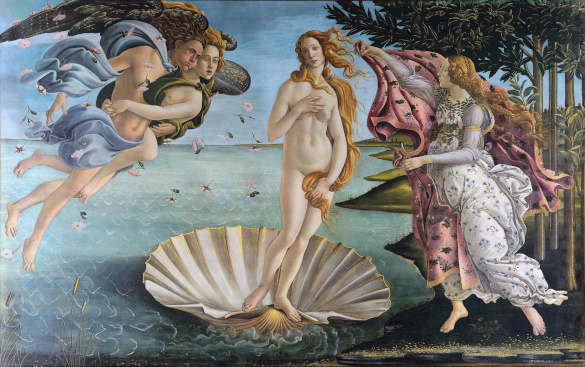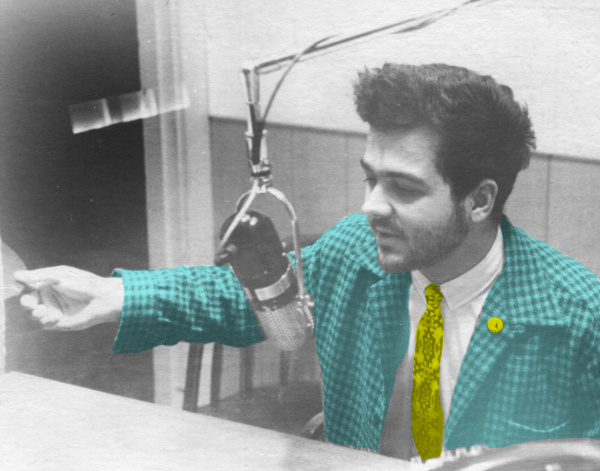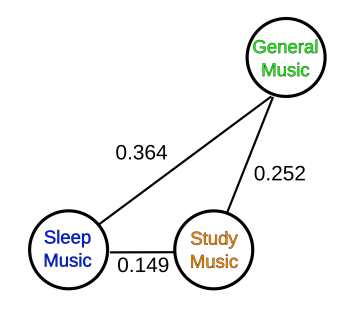Utilitarian Music
June 12, 2023
"
Music has
charms to
soothe a
savage breast," is the first line of the 1697
play,
The Mourning Bride, by
English poet and
playwright,
William Congreve (1670-1729). Congreve was a
contemporary of
Jonathan Swift (1667-1745), and his works were likewise critical of the
social values of his time. The saying is often misquoted as "savage
beast," possibly because there are still too many people in the world who are uncomfortable with any
blush of
sexuality.

"So, this isn't a nude beach?"
La nascita di Venere (The Birth of Venus), a circa 1485 tempera on canvas painting by Sandro Botticelli (1445–1510), now on display at the Uffizi Gallery (Florence, Italy).
Botticelli was careful not to have Venus reveal too much of her body, although the Venus de' Medici, a marble sculpture of Aphrodite on which the painting was based, is somewhat more revealing. The seashell on which she stands was a symbol for a woman's vulva in classical antiquity; thus, the origin of the slang term, "bearded clam."
(Wikimedia Commons image from Google Arts & Culture. Click for larger image.)
The oldest known
musical instrument is a 35,000 year old
Neanderthal flute made from a
vulture bone.[1] It was discovered in 2009 in a
cave in
southwest Germany, and its
construction was certainly aided by the fact that
bird bones are
hollow.[1] The 1958
film,
Teenage Caveman (
Roger Corman (b. 1926),
Director) has the main
character, portrayed by
Robert Vaughn (1932-2016), discovering that he can make music by
blowing across a hollow
reed.[2] There is evidence of a
hunting bow being used as a
string musical instrument in a cave painting from about 13,000
BC in the
Trois Frères cave in
France.[2]
The
Ancient Greek mathematician,
Pythagoras (c.570-c.495 BC), developed a
mathematical framework for
tone production in
strings. He found that a string half the length of another would
vibrate at half the
wavelength, and double the
frequency; and that strings of lengths in
whole number ratios to each other will generate more
pleasant sounds when played together. This so-called
just intonation will not produce unpleasant
beat frequencies.
Modern tuning, called
12-tone equal temperament, allows the playing of instruments in different
keys, and its mathematical basis is that the spacing between successive
notes (a
semitone) are in a ratio of the
twelfth root of 2 (
12√2).
There's a
Latin maxim, "
De gustibus non disputandum est (About taste, there is no argument)." There is no
argument about the
physics and mathematics of music, and there is also no arguing about a person's choice of music. A
Ph.D. materials scientist with whom I worked liked
bluegrass music. I always thought this
odd, but my own
family thought that my liking of the music of
Philip Glass (b. 1937) was odd. Some people enjoy "
elevator music," an example being
Muzak.

Top-40, News, Weather, and Sports.
I worked my way through an undergraduate education as a Top-40 disk jockey, and broadcast engineer for television and radio.
"Spinning the disks" had a format, symbolized by ACABAFAD, developed by musicologist and disk jockey, Bill Drake (1937-2008).
In this format (as I remember), songs played in a half hour consisted of A songs being in the Top-10, C songs as former members of the Top-10 trending downwards, B songs trending towards the Top-10, F oldies, and D (when time allowed), something that could be faded into the news.
Elevator music is one type of
utilitarian music; that is, music designed for a specific purpose, and the specific purpose of elevator music is to provide a soothing, non-intrusive
background that
masks other sounds. No one wants to
hear the
pre-lunch stomach rumbles of fellow
passengers, or the
mechanical noise of
motors and
cables used for the elevator function. People likewise set their
radio alarm clocks to a
loud music station that encourages them to jump out of
bed and start their
workday.
A recent
open access paper in
Scientific Reports by
scientists and
musicologists from
Aarhus University (Aarhus, Denmark), the
Royal Academy of Music Aarhus/Aalborg (Aarhus, Denmark), and the
University of Amsterdam (Amsterdam, The Netherlands) has examined the similarity of two types of utilitarian music; namely, music for
study and music for
sleep.[3-4] This is contrary to the expectation of the
mood-
arousal hypothesis that study music should be uplifting to boost arousal and increase
cognitive performance, whereas music used as a
sleep aid should be calm, gentle and slow to decrease arousal.[3]
At first glance, music for sleep should lower arousal, while music intended to induce better concentration while studying should increase arousal.[3] For studying, the so-called
Mozart Effect proposed that listening to
Mozart's Piano Concerto No. 23 (Köchel 488) increased performance on
spatial cognitive tasks in an
IQ test.[3] Today, the mood-arousal hypothesis proposes that this effect is caused by an increased arousal caused by pleasant music, such as Mozart
classical music.[3] Study music should be music of low
complexity having no
words, a stable
tonality and minimal changes in
tempo and loudness.[3] Whereas study music induces arousal while not not being too
distracting, sleep music should reduce arousal.[3]
Researching this topic was eased by the availability of
playlist data on
streaming services, such as
Spotify.[3] The research team examined playlists designed for studying or for
bedtime relaxation, and they found that these playlists had similar characteristics, such as slow tempo and
repetitive patterns.[4]
Statistical methods, such as
k-means clustering analysis, were used to compare the similarity of audio features between different playlists.[3-4] There were significant differences between sleep and general datasets in
Loudness,
Energy and
Valence (see table), but there was no large difference between the study and sleep playlists.[4]
The research
authors speculate that study music and sleep music both have a pleasant, non-disturbing auditory
environment, which lowers arousal for sleeping and enables increased
focus for study.[3] The repetitive patterns and slow tempo of the music help to lower
heart rate and reduced stress, and this creates a nice environment for both studying and sleeping.[4] Says
Rebecca Jane Scarratt, a study author and
Ph.D. candidate at the
Center for Music in the Brain at Aarhus University,
"Our study suggest that music used for studying and music used for sleeping share many characteristics in terms of tracks, genres and audio features. This similarity highlights the potential of music to create a pleasant but not too disturbing atmosphere, enabling individuals to focus on studying and relaxation for sleeping."[4]

The Kolmogorov–Smirnov distance between general music and sleep music, between sleep music and study music, and between general music and study music across all nine audio features as listed in the table.
(Created using Inkscape from data in fig. 4 of ref. 3.[3] Click for larger image.)
Of course, with so many varieties of musical genres and
audio features of selections within these genres, individual preferences are also important.[3] The exact influence of these music types on arousal still needs to be investigated, and there's no definitive explanation for the similarity of the affect of study music and sleep music beyond the idea that they both creates a pleasant and serene atmosphere that enables focus on studying and lower arousal for sleeping.[3]
References:
- What's the world’s oldest musical instrument?, BBC Music Magazine, August 10, 2022.
- Teenage Caveman, 1958, Roger Corman, Director, on the Internet Movie Database.
- Rebecca Jane Scarratt, Ole Adrian Heggli, Peter Vuust, and Makiko Sadakata, "Music that is used while studying and music that is used for sleep share similar musical features, genres and subgroups," Scientific Reports, vol. 13 (March 23, 2023), Article no. 4735, https://doi.org/10.1038/s41598-023-31692-8. This is an open access article with a PDF file available at the same URI.
- Music for sleeping and music for studying share surprising similarities, study finds, Aarhus University Press Release, April 20, 2023.
- Rebecca Jane Scarratt, Study-Sleep-Analyses Software, GitHub.
Linked Keywords: Music; charisma; charm; soothe; savage; breast; play (theatre); The Mourning Bride; England; English; poet; playwright; William Congreve (1670-1729); contemporary; Jonathan Swift (1667-1745); value (ethics and social sciences); social values; animal; beast; blushing; blush; human sexuality; Botticelli Birth of Venus; nude beach; La nascita di Venere (The Birth of Venus); tempera; canvas; painting; Sandro Botticelli (1445–1510); Uffizi Gallery (Florence, Italy); human body; Venus de' Medici; marble; sculpture; Aphrodite; seashell; symbol; woman; vulva; classical antiquity; etymology; origin; slang term; bearded clam; Wikimedia Commons; Google Arts; musical instrument; Neanderthal; flute; vulture; bone; cave; southwest; Germany; construction; bird; hollow; film; Teenage Caveman (1958 film); Roger Corman (b. 1926); film director; character (arts); Robert Vaughn (1932-2016); breathing; blowing; reed (plant); bow and arrow; hunting bow; string musical instrument; Anno Domini; BC; Trois Frères cave; France; Ancient Greek; mathematician; Pythagoras (c.570-c.495 BC); mathematics; mathematical; conceptual framework; pitch (music); tone; string (music); vibration; vibrate; wavelength; frequency; natural number; whole number; ratio; pleasure; pleasant; sound; just intonation; beat (acoustics); beat frequency; modern history; musical tuning; 12-tone equal temperament; key (music); musical note; semitone; nth root; twelfth root; Latin; maxim (literature); De gustibus non disputandum est (About taste, there is no argument); argument; physics; Doctor of Philosophy; Ph.D.; materials science; materials scientist; bluegrass music; weird; odd<; family; Philip Glass (b. 1937); elevator music; Muzak; Top-40; news; weather forecasting; sports commentator; undergraduate education; disk jockey; broadcast engineering; broadcast engineer; television; radio broadcasting; phonograph record; disk; radio format; symbol; symbolized; musicology; musicologist; Bill Drake (1937-2008); oldies; mixing console; fade; utility; utilitarian; background noise; sound masking; hearing; hear; pre-lunch; stomach; rumble (noise); passenger; machine; mechanical; noise; electric motor; cable; radio alarm clock; loudness; loud; bed; workweek and weekend; workday; open-access journal; open access paper; Scientific Reports; scientist; Aarhus University (Aarhus, Denmark); Royal Academy of Music Aarhus/Aalborg (Aarhus, Denmark); University of Amsterdam (Amsterdam, The Netherlands); study skills; sleep; mood (psychology); arousal; hypothesis; cognition; cognitive; insomnia; sleep aid; Mozart Effect; Mozart's Piano Concerto No. 23 (Köchel 488); three-dimensional space; spatial; intelligence quotient; IQ test; classical music; complexity; word; tonality; tempo; distraction; distracting; research; researching; playlist; data; streaming media; streaming service; Spotify; bedtime; stress relaxation; repetition (music); repetitive pattern; statistics; statistical; k-means clustering analysis; acoustic music; acoustical instrument; dance; dancing; intensity; human behavior; activity; vocal music; concert; live; audio signal; amplitude; spoken word; beat (music); duration (music); happiness; positive, happy, and cheerful; author; speculative reason; speculate; environment (biophysical); attention; focus; heart rate; Rebecca Jane Scarratt; Ph.D. candidate; Center for Music in the Brain at Aarhus University; genre; Kolmogorov–Smirnov distance; general music; audio signal processing; audio feature; Inkscape.